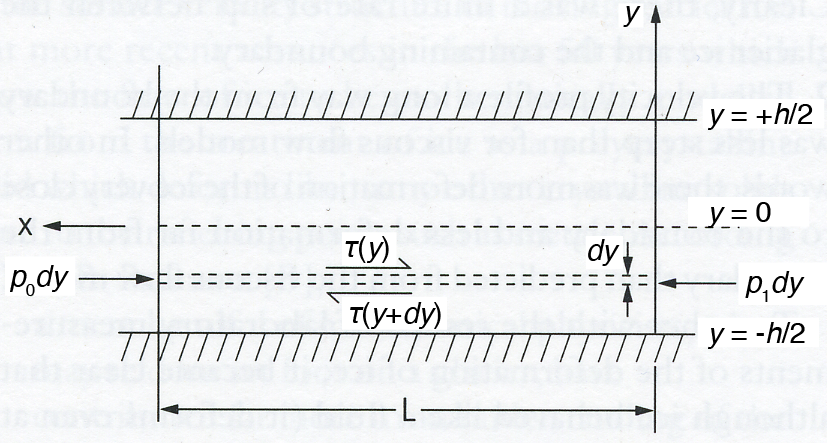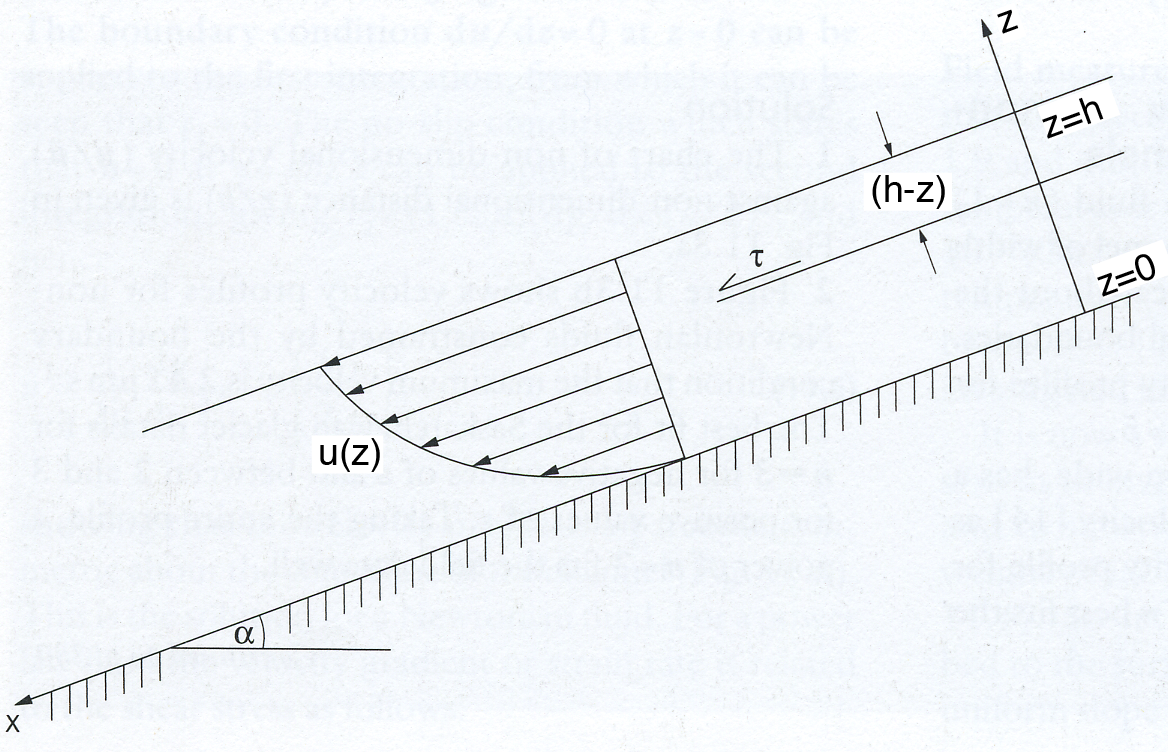Theory for Exercise 12¶
Problem 1¶
The viscosity of ice depends on both temperature and stress. For simplicity, we’ll consider the case where viscosity is only a function of shear stress. Consider a channel of width \(h\) centered about \(y = 0\), with lateral boundaries at \(y = \pm h/2\) (Figure 1). A pressure gradient \(\Delta p = p_{1} - p_{0}\) drives flow within the channel of length \(L\). The shear stress in the fluid depends on the applied pressure gradient and the distance from the channel boundaries
where \(\tau\) is the shear stress. We know that for Newtonian fluids
where \(\eta\) is the dynamic viscosity of the fluid. Substituting the right side of Equation 2 into the left side of Equation 1 we find
Integrating Equation 3 with respect to \(y\) twice we get
Since we know \(d u / d y = 0\) at \(y = 0\), we find \(c_{1} = 0\), and because we assume zero slip at the boundaries of the channel (\(u = 0\) at \(y = \pm h / 2\)), \(c_{2} = (1 / 2 \eta)(d p / d x)(h / 2)^{2}\). Thus,
This is the velocity profile for a Newtonian fluid, but as you will recall, we learned that ice is a non-Newtonian (nonlinear viscous) fluid. As such, the behavior should be modeled using a power-law, where the strain rate is a related to the shear stress as follows
where \(a\) is a function of the viscosity and temperature (we will ignore temperature for now), and \(n\) is the power-law exponent. If we solve Equation 7 in terms of \(\tau\), we can substitute the result into Equation 1 to get
Assuming symmetry about the center line \(y = 0\) and integrating we see
Note
In the derivations, boundary condition has been abbreviated as BC to save space.
Now integrate Equation 9 and assume \(u = 0\) at \(y = \pm h / 2\).
The mean velocity in the fluid is
We can calculate a non-dimensional velocity now by dividing the velocity at any point in the channel by the mean velocity
Problem 2¶
The velocity of a fluid flowing down an inclined plane can be modelled using some basic physical relationships. First, recall that the basal shear stress for a fluid flowing down an inclined plane is due to the down slope component of the weight of the overlying fluid
where \(\rho\) is the fluid density, \(g\) is the acceleration due to gravity, \(h\) is the thickness of the fluid perpendicular to the inclined plane and \(\alpha\) is the angle of the plane with respect to horizontal. At any distance \(z\) above the bed
where \(\gamma_{x} = \rho g \sin{\alpha}\) is the downslope component of the gravitational force. Combining Equation 2 from Part 1 of the theory with Equation 14 we find the constitutive equation for a Newtonian fluid is
Integrating Equation 15 yields
where \(c_{1} = 0\) from the boundary condition \(u = 0\) at \(z = 0\). Equation 16 can be rewritten as
For a non-Newtonian fluid, Equation 14 can be modified to account for the case where the strain rate varies as a power of the shear stress (Equation 7 from Part 1 of the theory)
To determine the velocity profile, we need to integrate Equation 18. If we use the boundary condition that the basal sliding velocity is equal to ub rather than zero, we get

